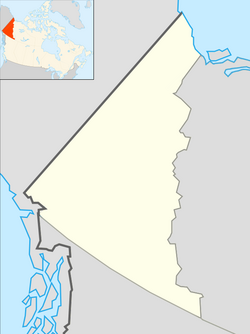Dawson, Yukon
| Dawson City | |
|---|---|
| Town | |
| Town of the City of Dawson | |

Aerial view of Dawson City with the Yukon River
|
|
| Nickname(s): Paris of the North | |
| Location of Dawson City in Yukon | |
| Coordinates: 64°03′36″N 139°24′39″W / 64.06000°N 139.41083°WCoordinates: 64°03′36″N 139°24′39″W / 64.06000°N 139.41083°W | |
| Country | Canada |
| Territory | Yukon |
| Settled | 1896 |
| City | 1902 |
| Town | 1980 |
| Government | |
| • Mayor | Wayne Potoroka |
| Area | |
| • Total | 32.45 km2 (12.53 sq mi) |
| Elevation | 370 m (1,214 ft) |
| Population (2011) | |
| • Total | 1,319 |
| • Density | 40.7/km2 (105/sq mi) |
| Time zone | Pacific (PST) (UTC-8) |
| • Summer (DST) | PDT (UTC-7) |
| Canadian Postal code | Y0B 1G0 |
| Area code(s) | 867 |
| NTS Map | 105D11 |
| GNBC Code | KAHFT |
| Climate | Dfc |
| Website | www.cityofdawson.ca |
The Town of the City of Dawson, commonly known as Dawson City or Dawson, is a town in Yukon, Canada. It is inseparably linked to the Klondike Gold Rush. The population was 1,319 at the 2011 census.
The townsite was founded by Joseph Ladue and named in January 1897 after noted Canadian geologist George M. Dawson, who had explored and mapped the region in 1887. It served as Yukon's capital from the territory's founding in 1898 until 1952, when the seat was moved to Whitehorse.
Dawson has a much longer history, however, as an important harvest area used for millennia by the Hän-speaking people of the Tr’ondëk Hwëch’in and their forebears. The heart of their homeland was Tr'ochëk, a fishing camp at the confluence of the Klondike River and Yukon River, now a National Historic Site of Canada. This site was also an important summer gathering spot and a base for moose-hunting on the Klondike Valley.
Dawson City was the centre of the Klondike Gold Rush. It began in 1896 and changed the First Nations camp into a thriving city of 40,000 by 1898. By 1899, the gold rush had ended and the town's population plummeted as all but 8,000 people left. When Dawson was incorporated as a city in 1902, the population was under 5,000. St. Paul's Anglican Church built that same year is a National Historic Site.
The population dropped after World War II when the Alaska Highway bypassed it 300 miles (480 km) to the south. The economic damage to Dawson City was such that Whitehorse, the highway's hub, replaced it as territorial capital in 1953. Dawson City's population languished around the 600–900 mark through the 1960s and 1970s, but has risen and held stable since then. The high price of gold has made modern placer mining operations profitable, and the growth of the tourism industry has encouraged development of facilities. In the early 1950s, Dawson was linked by road to Alaska, and in fall 1955, with Whitehorse along a road that now forms part of the Klondike Highway.
...
Wikipedia

